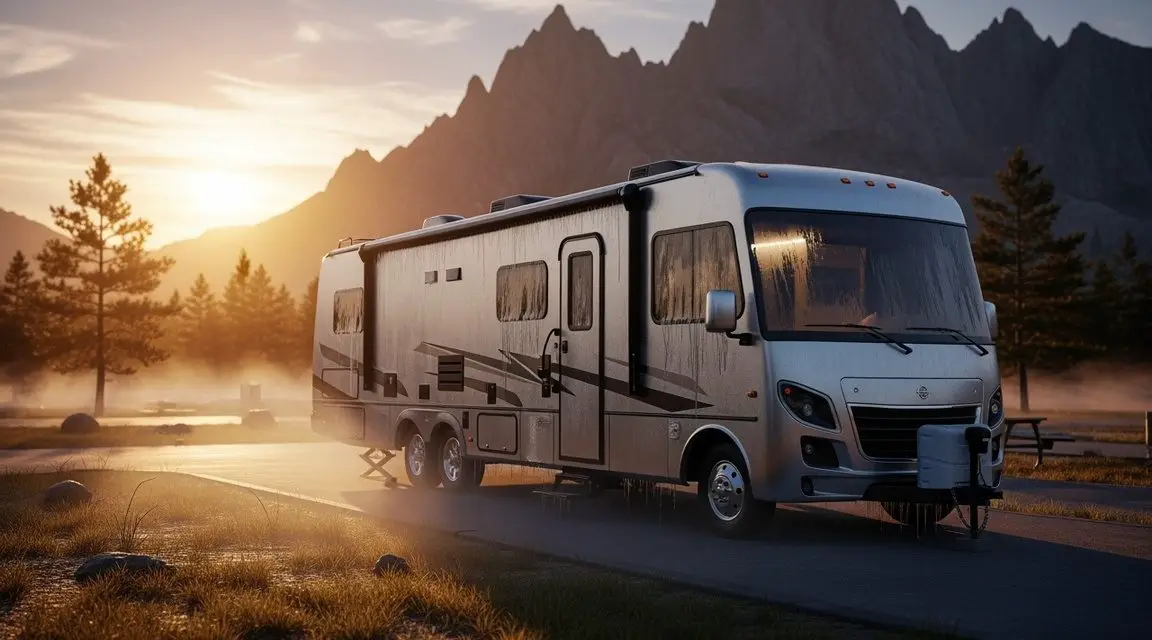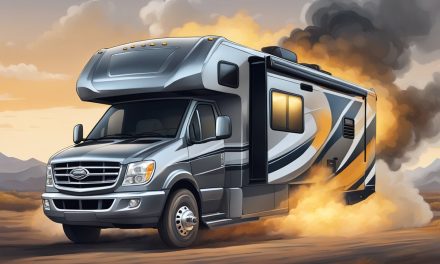Would you like to save this article?
Ready for the adventure of a lifetime in your new RV? Think again. What should have been Jesse’s dream journey across America quickly turned into a health-threatening nightmare that had her fleeing to hotel rooms and fighting manufacturers for months. Her brand-new Grand Design travel trailer came with more moisture than a rainforest, electrical hazards that could melt metal, and construction defects that would make you wonder if the factory workers were blindfolded.
This isn’t just another “buyer beware” story – it’s a wake-up call about what’s really happening in RV factories today. You’ll discover why even brand-new RVs are failing catastrophically and what red flags you need to watch for before you hand over your hard-earned money.
1. Dangerous Moisture Levels That Made Her Sick
Jesse’s 2025 Grand Design Transcend 151BH became a portable swamp within days. Her humidity meter showed readings over 80% – levels so high that moisture was literally condensing on her hanging clothes every morning. Food items in bags and boxes became soggy disasters, and the air became so thick you could practically swim through it.
What makes this particularly alarming: Normal indoor humidity should stay between 30-50%. Anything above 60% creates perfect conditions for mold growth, which can trigger respiratory problems, allergies, and serious health issues. Jesse started experiencing throat irritation and breathing difficulties within weeks.
| Humidity Level | Health Risk | Jesse’s Experience |
|---|---|---|
| 30-50% | Safe | Never achieved |
| 50-60% | Slight concern | Exceeded daily |
| 60-70% | Mold risk | Constant problem |
| 80%+ | Health hazard | Jesse’s reality |
You’d think manufacturers would test for this basic habitability issue, but apparently, creating a livable environment takes a backseat to rushing units off the production line. When your brand-new home on wheels becomes more humid than a tropical jungle, you know quality control has left the building entirely.
2. Roof Seals That Failed Before the First Trip
The mobile RV technician discovered Jesse’s roof had an unsealed section near the bathroom vent – a factory defect that allowed rainwater to pour directly into the wall cavities. This wasn’t wear-and-tear from years of use; this was sloppy workmanship from day one.
Industry statistics reveal a troubling pattern: According to repair shop reports, roof seal failures are among the top 3 most common defects in new RVs. Water intrusion damages insulation, creates mold colonies, and can destroy the structural integrity of walls and floors.
The technician also found additional concerns including bulging seams and other questionable roof construction. You’d expect a $30,000+ investment to keep rain outside where it belongs, but modern manufacturing seems to treat waterproofing as an optional feature.
3. Electrical Systems Hot Enough to Melt Metal
Jesse’s ceiling lights weren’t just bright – they were dangerously overheating to 105°F and climbing. The temperature was so extreme that it melted the electrical tape right off the technician’s testing meter. This isn’t just a comfort issue; it’s a fire hazard waiting to happen.
Electrical fires account for approximately 13% of RV fires annually according to NFPA data. When factory-installed lighting systems reach temperatures that can melt materials, you’re essentially living with a potential ignition source above your head every night.
You might assume that electrical components in a brand-new RV would be properly rated and installed, but Jesse’s experience suggests that even basic electrical safety isn’t guaranteed anymore. When your lights could literally cook an egg, it’s time to question what other “features” might be ticking time bombs.
4. Doors That Won’t Lock – A Security Nightmare
By the third night of Jesse’s camping experience, her entry door refused to lock from the inside. Picture this: you’re alone in an RV at a campground, and your primary security barrier won’t engage. The technician later discovered the door was damaged during manufacturing – someone had apparently hammered the bottom of the door trying to force it to fit properly.
The strike plate was installed in the wrong location, making proper locking impossible. This wasn’t a design flaw or user error; this was pure manufacturing negligence. The damage was so obvious that it pulled down the gutter above the door.
You’d expect basic security from any dwelling, but modern RV manufacturing apparently considers functional locks as optional equipment. When factory workers are literally beating doors with hammers to make them “fit,” you know quality standards have become a distant memory.
5. Air Conditioning Systems That Create Humidity Instead of Removing It
Jesse’s AC unit had a major design flaw: you couldn’t turn off the fan. It circulated air constantly, which sounds helpful until you realize that in a small space with existing moisture problems, constant air circulation without proper dehumidification actually makes humidity worse.
The physics are simple: Air conditioners remove humidity as a byproduct of cooling, but only when they run proper cooling cycles. When the fan runs continuously without adequate cooling cycles, it just stirs the moist air around without extracting water vapor.
Jesse had to purchase two dehumidifiers – first a small countertop unit that filled up multiple times per day, then a full-sized unit that consumed most of her walking space in the tiny 19-foot trailer.
| Dehumidifier Size | Daily Water Removal | Space Impact |
|---|---|---|
| Countertop | 2-3 emptying cycles | Minimal |
| Full-size | Continuous operation | 50% of walking space |
You’d think an air conditioning system would improve air quality, but in Jesse’s case, it became part of the problem. When your AC makes living conditions worse instead of better, you’re not buying comfort – you’re purchasing a humidity generator with cooling side effects.
6. Customer Service That Plays Hot Potato
Jesse’s experience with Grand Design’s customer service became a months-long game of corporate ping-pong. Alan Smith, Grand Design’s consumer affairs manager, bounced responsibility between the manufacturer and Blue Compass RV dealer for months, with each party claiming the other would handle repairs.
The timeline tells the story:
- March 19th: Initial deposit and pressure to buy immediately
- April 22nd: Promised delivery with unrepaired damage
- May 27th: Mobile tech discovers major defects
- June: Entire month of back-and-forth with no resolution
- July 7th: Finally authorized for repair (not refund)
Industry pattern: According to consumer advocacy channels, this run-around approach is becoming standard practice in RV customer service. Manufacturers delay and deflect hoping customers will give up or accept inadequate repairs.
You’d expect customer service to actually serve customers, but Jesse’s experience shows that modern RV companies treat warranty claims like expensive nuisances rather than legitimate quality failures. When a brand-new product fails catastrophically and the manufacturer’s response is months of bureaucratic shuffling, you’re not buying customer service – you’re purchasing a frustration subscription.
7. The Inspection That Should Have Happened Before Purchase
The mobile technician told Jesse something that should terrify every RV buyer: “You have to have them inspected because of the way they’re made these days. It’s low-quality standards and when they’re rushing them out doing all of their piece work, it doesn’t make for good manufacturing practices.”
This professional’s assessment reveals the industry’s dirty secret: Quality control has deteriorated so badly that even brand-new RVs require independent inspections to ensure basic functionality and safety.
Statistics from independent RV inspectors show:
- 70% of Grand Design RVs suffer from frame issues according to one repair shop
- Water intrusion problems are found in approximately 40% of new RV inspections
- Electrical defects appear in roughly 25% of factory deliveries
The inspection Jesse should have gotten would have cost around $500-800 but could have saved her thousands in hotel costs, lost vacation time, and health impacts.
You might assume that paying full price for a brand-new RV guarantees you’re getting a properly built product, but industry professionals now recommend treating every new RV like a used car purchase – complete with professional inspection. When RV technicians openly admit that factory quality is so bad that all new units need inspection, you’re not buying peace of mind – you’re purchasing a very expensive lottery ticket.
What Grand Design Should Do (And What You Should Demand)
Jesse’s case isn’t isolated – it’s becoming the norm. Grand Design has successfully resolved similar cases in the past through buybacks and replacements, but this time they’re refusing to take responsibility for their manufacturing defects.
Here’s what should happen:
- Full refund for the defective unit
- Reimbursement for hotel costs during uninhabitable period
- Compensation for lost vacation time and health impacts
What this means for you as a buyer:
- Always get independent inspections on new RVs
- Document everything with photos and videos
- Don’t accept delivery with known defects
- Know your state’s lemon laws for RVs
- Budget for immediate repairs even on new units
Sources
- RV Travel – Grand Design Quality and Frame Flex Issues
- Better Business Bureau – Grand Design RV Complaints
- Grand Design RV Frame Failure Lawsuit
- California RV Specialists – Roof Sealing Failure Consequences
- nuCamp RV – Controlling Humidity in Your Camper
- YouTube – Liz Amazing Channel





